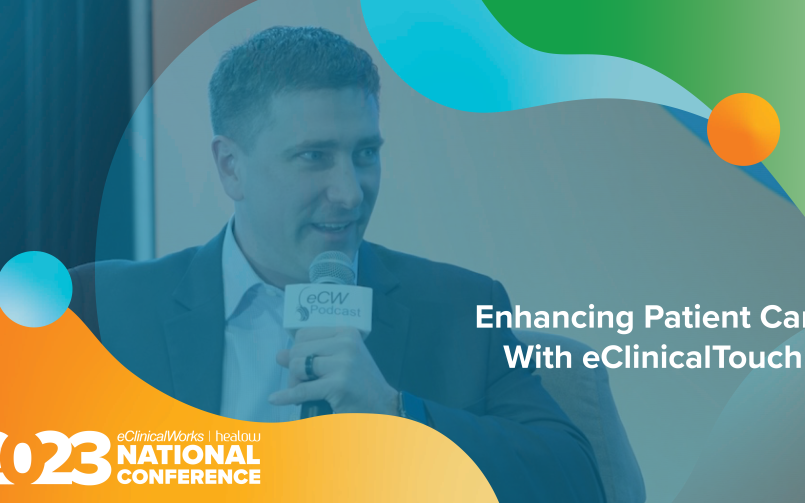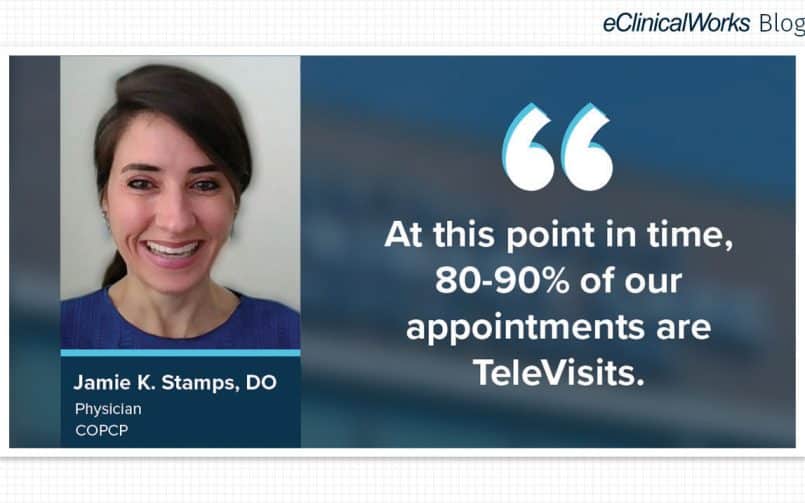AI Medical Scribes in Remote Healthcare Services
- 15 February 2024
- Blog
eClinicalWorks

The global pandemic put a spotlight on the importance of telemedicine in healthcare. It has brought healthcare services to the comfort and safety of people’s homes while offering quality care.
Proper documentation is the backbone of effective healthcare delivery. It ensures continuity and quality of care, allowing healthcare professionals to track a patient’s health journey. As telemedicine grows, the sheer volume of patient interactions can make maintaining that documentation an uphill battle.
Given the digital nature of telemedicine, maintaining documentation can become overwhelming for healthcare providers who already have their hands full.
The AI Medical Scribe Solution: Changing the Game
This is where the AI medical scribe enters the conversation. This innovative dictation scribe designed specifically for healthcare providers eases the burden of documentation by taking notes for them. In real time, the AI medical scribe listens to the patient-provider conversation during the telehealth visit, transcribes the conversation, and seamlessly integrates the data into the patient’s record in the Electronic Health Record (EHR).
This ensures that every detail from the conversation is captured and stored systematically without extra effort from the healthcare provider. Relieved of the note-taking burden, providers can focus where it’s needed most – on their patients.
Sunoh.ai is an AI medical scribe that uses intelligent voice recognition technology and natural language processing tools to transcribe patient-provider conversations into clinical documentation. It’s a conversational AI that offers a unique and immersive experience for doctors and patients, making the documentation of clinical notes faster and more efficient.
eClinicalWorks® (eCW) recently integrated with Sunoh.ai to provide a seamless documentation experience to our customers, along with a series of cutting-edge transformative AI functionalities. Sunoh.ai is available to eCW practices on multiple devices, including eClinicalMobile® and eClinicalTouch® apps.
AI medical scribes in telemedicine can:
- Instantly transcribe patient-provider conversations
- Allow healthcare providers to focus more on the patient rather than on taking notes
- Save time for clinicians during telemedicine services
- Improve efficiency
Advantages of AI Medical Scribes in Remote Healthcare Services
Focused Care
With an AI medical scribe, providers don’t need to split their attention between the patient and taking notes. Instead, they can focus exclusively on the patient and care, making diagnoses and developing treatment plans while the AI medical scribe takes notes.
Better-Informed Decisions
AI medical scribes capture the relevant information discussed during the telemedicine visit, including the patient’s medical history, symptoms, and treatment recommendations. This ensures that everything is documented and that the providers are armed with the information they need to make intelligent decisions about patient care.
Increased Productivity
AI medical scribes alleviate the burden of taking notes. This allows providers to see more patients in less time, leading to a more efficient and streamlined medical visit process.
Enhanced Patient Experience
With an AI scribe, patients can receive more personalized and focused care. With note-taking no longer a part of the one-on-one process, providers can spend more time focused on their patients, leading to better patient experiences and outcomes.
AI medical scribes offer significant benefits for telemedicine and remote healthcare services, from more efficient documentation and improved provider productivity to better-informed decisions and an improved patient experience. As telemedicine grows in popularity, AI medical scribes will become a valuable tool for healthcare providers looking to deliver high-quality care to their patients.
For more information on how an AI medical scribe can boost your telemedicine and remote healthcare services, visit Sunoh.ai.
Related Post

- 20 March 2025
- Blog
Sunoh.ai: The Trusted Multilingual AI Scribe

- 13 March 2025
- Blog
Spreading the Word About What Happened in Vegas

- 9 January 2025
- Blog
Unveiling Trends Set to Transform Healthcare in 2025

- 11 December 2024
- Blog
AI and the Age of Intelligence Has Arrived

- 27 November 2024
- Blog
eClinicalWorks: The One-Stop Solution for Cutting-Edge AI Tools

- 10 October 2024
- Blog
Sunoh AI Medical Scribe is Transforming Documentation in Women’s Specialty Clinic

- 4 October 2024
- Blog
Sunoh.ai – A New Horizon in Pain Management

- 27 September 2024
- Blog
Sunoh.ai – The Ultimate AI Scribe Solution for your Healthcare Practice

- 15 August 2024
- Blog
The ABCs of Back to School — for Patients and Practices

- 8 August 2024
- Blog
Revolutionizing Patient Care with eCW AI and Cloud-Based Solutions

- 1 August 2024
- Blog
eCW Users Excited to Implement AI at Their Practices

- 30 July 2024
- Blog
How AI Can Help the Healthcare Industry

- 26 July 2024
- Blog
How to Maximize Efficiency of an AI-Powered Medical Scribe

- 6 June 2024
- Blog
Dental Practices Keep Brushing Up on Technology

- 4 June 2024
- Blog
Physicians Have Limits — Healthcare IT Can Help

- 16 May 2024
- Blog
A Revolutionary Approach to Enhance Clinical Workflows

- 26 April 2024
- Blog
Scaling Your Practice for Success

- 18 April 2024
- Blog
Support Value-Based Care with Sunoh.ai

- 11 April 2024
- Blog
Revolutionizing Visit Notes with AI-Powered Ambient Listening Technology

- 4 April 2024
- Blog
Leveraging AI: eClinicalWorks Reimagining Healthcare Delivery

- 14 March 2024
- Blog
Revolutionizing Work-Life Balance with a Smart AI-Driven EHR

- 8 February 2024
- Blog
The Benefits of Multifaceted AI Scribe Accessible on Multiple Devices

- 6 February 2024
- Blog
Priority One for 2024: Staying Focused on Patients

- 1 February 2024
- Blog
Healthcare 2024: Trends to Look for in the Year Ahead

- 29 January 2024
- Blog
Benefits of Medical AI Scribe Integrated within the EHR

- 10 January 2024
- Blog
Enhancing Primary Care with eClinicalTouch 4

- 27 December 2023
- Blog
eClinicalWorks 2023 Year in Review

- 7 November 2023
- Blog
Embracing Technology for Startup Weight Loss and Medical Spa Clinics

- 27 September 2022
- Blog
Back to School — for Your Practice, Too!

- 21 June 2022
- Blog
Dermatology Made Easier This Summer

- 25 March 2022
- Blog
HIMSS22 Outlines Opportunities in Healthcare

- 17 February 2022
- Blog
Defense Matters: Keeping Remote Medicine Safe

- 1 February 2022
- Blog
One Key for 2022: Staying Focused on Patients

- 28 January 2022
- Blog
4 Patient Engagement Solutions to Help Patients and Practices in 2022

- 25 January 2022
- Blog
The Right Tools During Challenging Times

- 19 January 2022
- Blog
Healthcare 2022: Regulatory Trends to Look for in the Year Ahead

- 18 November 2021
- Blog
Remaining Vigilant in the Lung Cancer Fight

- 4 November 2021
- Blog
Telehealth Is Long-Established Science Fact

- 2 September 2021
- Blog
It’s Time for a Better Check-in Solution

- 27 May 2021
- Blog
When Neurological Care Cannot Wait

- 16 March 2021
- Blog
A Partner for Reinventing Your Practice

- 2 March 2021
- Blog
What it Takes to Better Know Your Patients

- 29 January 2021
- Blog
Putting the Pieces Together for Quality Healthcare

- 30 December 2020
- Blog
2020 eClinicalWorks Year in Review

- 22 December 2020
- Blog
Thirlby Clinic: Using Telehealth and CCM for Better Disease Management

- 15 December 2020
- Blog
A Challenging Year Is Ending — New Opportunities Ahead

- 10 December 2020
- Blog
How a Practice Found Success With Telehealth & Contactless Check-In

- 24 November 2020
- Blog
The Continuing Influence of Telehealth

- 19 November 2020
- Blog
Meeting the Demand for Behavioral Health Services

- 12 November 2020
- Blog
Reinventing Healthcare for a Brighter Future

- 6 November 2020
- Blog
How Little River Medical Center Thrived During the Pandemic

- 19 October 2020
- Blog
How Telehealth, CCM, and Contactless Check-In Revitalized a Practice in Need

- 15 October 2020
- Blog
Targeting Behavioral Health, Remote Care & More

- 30 September 2020
- Blog
Surviving COVID-19: Telehealth and Beyond

- 21 September 2020
- Blog
3 Important healow TeleVisits Features

- 1 September 2020
- Blog
Back to the Basics During the COVID-19 Era

- 28 August 2020
- Blog
How the Patient Portal Is Making a Difference for a Pediatric Practice

- 24 July 2020
- Blog
Pushing Boundaries, Reaching New Horizons

- 17 July 2020
- Blog
How to Keep Your Patients & Staff Safe During COVID-19

- 1 July 2020
- Blog
How to Digitize Your Front Office

- 29 June 2020
- Blog
The Telehealth Revolution Continues

- 24 June 2020
- Blog
How Advocare Put healow TeleVisits™ to Work

- 17 June 2020
- Blog
How Telehealth Is Connecting Patients & Providers

- 12 June 2020
- Blog
Finding a New Normal: The Patient Experience

- 10 June 2020
- Blog
Minding Mental Health During COVID-19

- 3 June 2020
- Blog
Expanding the Range of Specialty Care

- 1 June 2020
- Blog
Reinventing Your Practice

- 29 May 2020
- Blog
What Telehealth Could Mean for Practices Today

- 27 May 2020
- Blog
Resourceful Action During Extreme Times

- 21 May 2020
- Blog
Like Telehealth? There’s More!

- 19 May 2020
- Blog
The Numbers Behind TeleVisits

- 16 May 2020
- Blog
What Telehealth Can Do for Specialty Practices

- 13 May 2020
- Blog
Routine Care During Nonroutine Times

- 12 May 2020
- Blog
How Telehealth Will Make The 21st Century Ours

- 8 May 2020
- Blog
Seeing Medicine in a New Light

- 7 May 2020
- Blog
Telehealth: Healing Action at a Distance

- 5 May 2020
- Blog
3 Patient Stories of TeleVisits in Action

- 1 May 2020
- Blog
Sustaining Medical Practice During COVID-19

- 29 April 2020
- Blog
The Evolution and Importance of Telehealth

- 27 April 2020
- Blog
Deriving Greater Value from Telehealth

- 24 April 2020
- Blog
3 Practices Finding Success With Telehealth

- 22 April 2020
- Blog
How Innovation Fueled the Rise of Telehealth

- 20 April 2020
- Blog
Why You Should Activate Telehealth Today

- 17 April 2020
- Blog
3 Practices Using Telehealth to Improve Patient Care

- 15 April 2020
- Blog
Shift in the Medical Mindset

- 13 April 2020
- Blog
How Telehealth Kept a Patient Out of the ER

- 10 April 2020
- Blog
Speeding Toward a New Healthcare Paradigm

- 9 April 2020
- Blog
How Dallas Renal Group is Providing Care While Social Distancing

- 8 April 2020
- Blog
Swift Action Results in Change of Telehealth Regulations

- 7 April 2020
- Blog
How Central Ohio Primary Care Physicians is Reducing ER Visits

- 6 April 2020
- Blog
Securing Access to Care During a Pandemic

- 3 April 2020
- Blog
How Telehealth is Keeping Patients Safe at Trusted Doctors

- 2 April 2020
- Blog
Flattening the Curve With Telehealth

- 1 April 2020
- Blog
How First Choice Neurology Transformed Their Practice With Telehealth

- 31 March 2020
- Blog
Telehealth and Mental Health in a Time of Crisis

- 27 March 2020
- Blog
How SG Pediatrics are Using TeleVisits to Help Patients

- 26 March 2020
- Blog
The eClinicalWorks Telehealth Advantage

- 25 March 2020
- Blog
How Televisits Have Transformed Comprehensive Sleep Center

- 24 March 2020
- Blog
Telehealth: Helping Throughout History

- 23 March 2020
- Blog
How healow TeleVisits Can Help During a Health Crisis

- 20 March 2020
- Blog
healow TeleVisits: How Fast Deployment Helps

- 11 March 2020
- Blog
Expanding Access to Care With healow TeleVisits

- 8 January 2020
- Blog
The State of Telehealth in 2020

- 14 August 2019
- Blog
Patient-Centered Care: How the Approach Can Improve Healthcare

- 5 June 2019
- Blog
3 Ways That Telehealth Is Improving Healthcare

- 9 January 2019
- Blog
Telehealth – Rural Health Center

- 1 November 2018
- Blog
Three Ways Telemedicine Improves Care for Providers and Patients

- 21 December 2017
- Blog
Singletrack: Small Is Beautiful, and It Just Might Last
- 20 March 2015
- Blog
The Next Phase of Innovation in Healthcare
- 20 March 2015
- Blog










